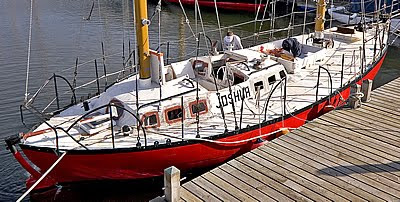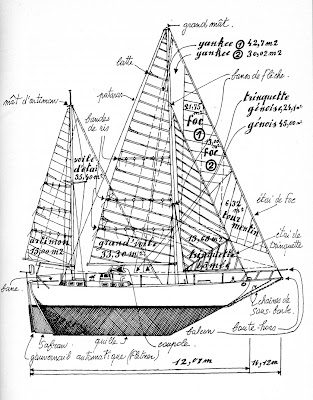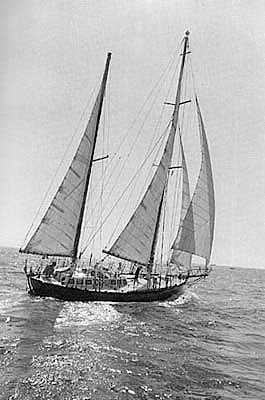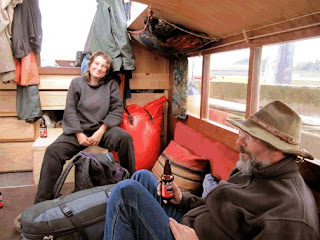Readers of novels are willing to believe the most outrageous and tortuous plots - in the case of my, as yet, unfinished novel it's about unethical journalism, civil service corruption and murderous politicians - but only if the small, familiar details are correct. Since the central character in the tale I am currently writing, has to sail through, and survive, a terrifyingly violent storm, and later prevail in a fight with one of the chief villains, while navigating the overfalls of a treacherous tiderace, in a wind-over-tide gale, (guess who goes overboard!) my choice of boat was an easy one. Just as James Bond would not be credible without his Walther pistol and his Aston Martin, my story's hero, so my theory goes, could not be sent into stormy waters in an inadequate boat. If the detail is wrong, the plot will sink without trace.
![]() The above, I hope, helps explain two things; why I have been too occupied to write here for a couple of months, and why I'm now writing about a Finnish boat instead of a French one.
The above, I hope, helps explain two things; why I have been too occupied to write here for a couple of months, and why I'm now writing about a Finnish boat instead of a French one.
The Swan 38 is one of my two or three favourite ever boats, and the only one I could choose for my fictional hero. If I wanted a boat I could trust to last me for the rest of my life, and to take me anywhere I desired to sail, the Sparkman and Stephens designed Swan 38 would be number one on my list. In terms of quality of build, design pedigree, strength, longevity and looks, this boat can stand comparison with any other yacht produced anywhere, at any time. But what makes the Swan 38 better, to my mind, than any other yacht of its size, is its ability to make open sea passages in all weathers, while keeping its crew comfortable, confident, and rested.
The design was commissioned from the legendary New York architects Sparkman and Stephens by the Finnish yachtbuilders Oy Nautor Ab in 1974. Nautor had already had considerable commercial success with a series of S&S designed Swans ranging from 36 to 65 ft LOA. The Swan 38 was designed as a more compact version of their outstandingly successful 1967 Swan 43 design, which had proved to be a fast boat at every level of racing competition, even winning a place in the 3 boat British Admiral's Cup team of 1969.
At the time of its introduction, Nautor had recently undergone a change of management, but the new owners were as determined as the founder, Pekka Koskenkylä, to build yachts of the highest quality. The 38 is no exception. It's backbone is a massive stainless steel girder, solidly glassed into the bottom of the hull. This rigid base carries the loads of the mast and of the 7000lb keel and endows the GRP hull with enormous strength and stiffness. Most of the boats were built with a teak deck beautifully laid on top of the GRP top moulding. This deck, though lovely to look at, will inevitably need replacing one day at considerable cost, and for the keen racer, its weight must be considered unnecessary. But, if you're thinking of becoming the owner of a Swan, you will probably be prepared to put up with the extra expense, every quarter-century or so, in order to be able to walk those teak planks.
![]() No doubt experts will correct me if I'm wrong, but I believe the 38 was the first of the Swans to sport the signature, low, slope-sided, coachroof wedge which seems to grow out of the deck and merge into the cockpit coaming, and which, for a time, became a characteristic feature of the marque, until it was copied by many other designers. This feature makes the decks appear wider and allows excellent forward visibility from the cockpit.
No doubt experts will correct me if I'm wrong, but I believe the 38 was the first of the Swans to sport the signature, low, slope-sided, coachroof wedge which seems to grow out of the deck and merge into the cockpit coaming, and which, for a time, became a characteristic feature of the marque, until it was copied by many other designers. This feature makes the decks appear wider and allows excellent forward visibility from the cockpit.
Down below the joinery is immaculately made and polished to a cabinetmaker's finish. The Swan 38 was considered a roomy yacht in its day, and although it can't now compare for spaciousness with modern yachts of similar overall length, the hull's deep sections and relatively substantial displacement give it plenty of volume, so storage space is generous and useful.
Unlike the larger 43 of the same era, the main saloon is abaft the through-deck mast, so the social space is unobstructed. There are good seagoing pilot berths outboard of the settee berths so that the off-watch crew can sleep securely in bad weather.
![]()
The forward facing chart table to port allows the navigator to work on a large flat area, with bulkhead space for instruments, under-desk storage for charts, and, on some boats, a useful shelf for pilot books, without disturbing any resting crew. It is separated from the decent size galley opposite by the engine box and companionway steps. Behind the navigator there is a good size oilskin locker.
Further aft there is a usefully private, if slightly cramped, aft cabin under the cockpit. It is reached by a short passage on the port side, and it offers a double berth for when you get lucky in harbour, as well as a single quarter berth to port. There's not much headroom here, but the space gives the owner or skipper some privacy, and allows him, or her, while lying in the starboard double berth, to communicate with the crew through an opening hatch to the saloon, or through a small opening port into the cockpit.
Forward of the mast there is an adequately roomy WC/shower compartment to port with hanging locker and drawer space to starboard. Further forward still, the forecabin is dominated by bin stowage for the wardrobe of racing sails that a yacht of this type would have been expected to carry. Pipecots fold down over the bins when needed for harbour use. Many of the boats have now been adapted, for cruising or charter, by having this space converted into a proper cabin for two with a permanent 'V' berth.
![]() The cockpit is comfortable but not overlarge, as in inshore racing situations most of the crew would be on deck, either perched on the weather rail or operating halyards, downhauls and winches grouped on a flat working area of the cabin roof abaft the mast. When racing or cruising offshore, only half the crew could be expected to be in the cockpit at once; the rest would be below for much of the time. There is a liferaft stowage locker to port, and a bridge deck which, together with a single shallow hatch slide, prevents water from a flooded cockpit entering the cabin.
The cockpit is comfortable but not overlarge, as in inshore racing situations most of the crew would be on deck, either perched on the weather rail or operating halyards, downhauls and winches grouped on a flat working area of the cabin roof abaft the mast. When racing or cruising offshore, only half the crew could be expected to be in the cockpit at once; the rest would be below for much of the time. There is a liferaft stowage locker to port, and a bridge deck which, together with a single shallow hatch slide, prevents water from a flooded cockpit entering the cabin.
The Swan 38 is an easy boat to sail. Her wide decks enable rapid and safe crew movement for sailhandling and harbour manoeuvres, and the simple, single-spreader rig enables her to be sailed shorthanded. Being a pedigree S&S design, she handles beautifully on all points of sailing, especially to windward, when she can be trimmed to balance perfectly with just enough weather helm for feel. Like most IOR inspired yachts of her day she can sometimes be a handful when sailing fully-powered dead downwind.
Production of the Swan 38 ended in 1979 with 116 hulls built. Today most examples will have been fitted with headsail roller reefing gear and modern electronic navigation aids. The best examples will have been professionally maintained by a top quality yard and may have new teak decks and an upgraded modern diesel. If you want one you will probably have to spend £70-100,000, but this could turn out to be an excellent investment, as prices are unlikely ever to fall below today's.
The Swan 38, in my opinion, is the best cruiser/racer ever. She may not be as fast downwind in smooth water as a some other boats of her size. She may not be as roomy as most more modern 38 footers. She won't plane on a reach at 15 knots in a 12 knot breeze like some of today's ultra-lightweight scaled-up dinghies. She is, however, one of a very few great sailing boats that can win races, cross oceans, go weekend family cruising or shorthanded passage making and can be absolutely relied on to make ground to windward in gale force wind and heavy seas when your life depends on it. As a bonus, she is strongly built and finished to immaculate standards by Nautor of Finland, a marque which, for yachtsmen of my age, carries the same exclusive cachet and promise of quality, as the Rolls-Royce brand once did for motorists.
![]()
Swan 38
Designer: Sparkman & Stephens
Builder: Oy Nautor Ab (now called Nautor's Swan)
LOA 38'-0"
LWL 28'-9"
Beam 11'-7"
Draft 6'-4"
Displacement 16,120 lbs
Ballast 7,050 lbs
Sail Area 682 sq ft
Acknowledgements:
Thanks to James Bull of Swan Yacht Charter for permission to use the images shown here. More photos and details of the Swan 38 "Cimaroon", available for charter, can be found at the Swan Yacht Charter website
Further links:
Article at Boats.com
Sparkman & Stephens (to view drawings and plans)
 When stories are told about the early days of short and single-handed long distance ocean racing, the names of Chichester, Hasler and the French hero Eric Tabarly are the most easily remembered. It's often forgotten that only one Frenchman took part in the first Observer Singlehanded Transatlantic race - and it wasn't Tabarly.
When stories are told about the early days of short and single-handed long distance ocean racing, the names of Chichester, Hasler and the French hero Eric Tabarly are the most easily remembered. It's often forgotten that only one Frenchman took part in the first Observer Singlehanded Transatlantic race - and it wasn't Tabarly. Lacombe's “Cap-Horn” was a compact weekend family cruiser of 21ft overall, built by Jouet, a well established boat building firm in Sartrouville, on the River Seine. It was a design that, though simple, was rather more sophisticated than the type of basic small cruising boat that was becoming popular in France in the 1950s, when the influential Glenans Sailing School began to turn out a few dozen enthusiastic young sailors every summer.
Lacombe's “Cap-Horn” was a compact weekend family cruiser of 21ft overall, built by Jouet, a well established boat building firm in Sartrouville, on the River Seine. It was a design that, though simple, was rather more sophisticated than the type of basic small cruising boat that was becoming popular in France in the 1950s, when the influential Glenans Sailing School began to turn out a few dozen enthusiastic young sailors every summer.  The plywood Herbulot designs of the day, simple, compact, practical and inexpensive, were emblematic of French sailing in the '50s and early '60s. Just a year after the first OSTAR, however, France's first all-GRP production cruising boat emerged from the Jouet factory, and Cap-Horn's strong and lightweight cold moulded construction suddenly seemed old fashioned and labour intensive compared with the new high-tech material. (colour photo: the varnished hull of this 1964 Cap-Horn, recently for sale in France, has been well maintained and preserved.)
The plywood Herbulot designs of the day, simple, compact, practical and inexpensive, were emblematic of French sailing in the '50s and early '60s. Just a year after the first OSTAR, however, France's first all-GRP production cruising boat emerged from the Jouet factory, and Cap-Horn's strong and lightweight cold moulded construction suddenly seemed old fashioned and labour intensive compared with the new high-tech material. (colour photo: the varnished hull of this 1964 Cap-Horn, recently for sale in France, has been well maintained and preserved.) Cap-Horn built by P. Jouet & Cie, designed J. J. Herbulot
Cap-Horn built by P. Jouet & Cie, designed J. J. Herbulot







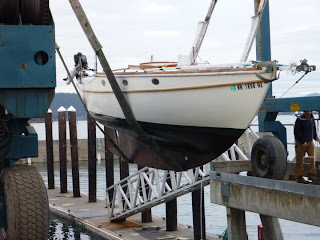



































 ", by Claude Harlé and Dominique Lebrun.
", by Claude Harlé and Dominique Lebrun.
